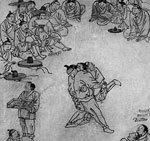Taekwondo 태권도Taekwondo Preschool
Korean martial arts are military practices and methods which have their place in the history of Korea but have been adapted for use by both military and non-military personnel as a method of personal growth or recreation.
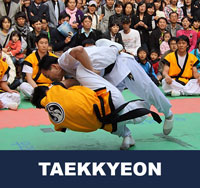
About Taekkyeon 택견
Taekkyeon is a traditional military Korean martial art first explicitly recorded in the Joseon Dynasty. It is frequently attributed as one of the progenitors of the more modern Korean martial art Taekwondo and its various sub-styles. Taekkyeon is characterized by fluid, dynamic footwork and utilizes a wide variety of kicks, fist and elbow strikes, pressure point attacks, throws, and grapples. It is also frequently romanized informally as Taekgyeon, Taekkyon, or Taekyun. In November 2011, Taekkyeon was recognized by UNESCO and placed on its Intangible Cultural Heritage List, being honored as the first martial art on UNESCO's list.
History of Taekkyeon
The earliest existing written source mentioning Taekkyeon is from the time of King Jeongjo, who reigned in Korea from 1776 to 1800. During this time, the book Jaemulbo (also Manmulbo) was written by Lee, Sung-Ji. The text says
"Byeon and Subak are Byeon, Gangnyeok is Mu and all these are called Tak-gyeon in Hangeul."
(卞 手搏爲卞 角力爲武 苦今之탁견)
—Jaemulbo
This means that Taekkyeon might derive from an earlier art called Subak. However, little is known about what exactly Subak was. Its practice never seems to have been widespread within the Korean peninsula, but around 1900 Taekkyon was practiced frequently around Hanyang, the old name of Seoul and the capital city of the Joseon Dynasty. Song Duk-ki (1893–1987) was critically responsible for conveying the art. In the foreword of his only book, he writes:
"It cannot be said for sure when and how taekkyon came into existence, but until the end of the Korean kingdom, certain people did taekkyon together."
—Song Duk-ki
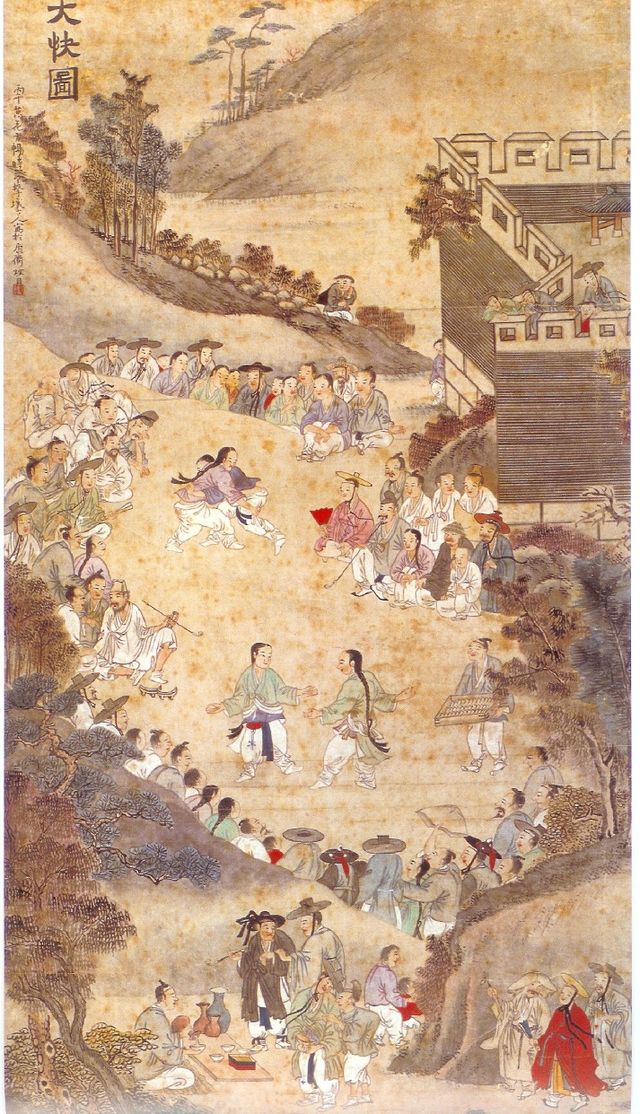
Taekkyeon matches were frequent in the late Joseon Dynasty. For example, during the Dano-Festival, a tournament called Gyeollyeon (결련) was carried out. Players who beat five opponents consecutively could take a rest and re-enter the tournament again later.
Taekkyeon is documented as a living martial art in an 1895 book on Korean sports and games.
In the book "Haedong Jukji" by Choe Yeong-nyeon (최영년, Hanja: 崔永年) from 1921, the idu-writing 托肩 is used to represent "Tak-gyeon". The translation of 托肩 is "push-shoulder". However this does not mean that the translation of Taekkyon is "push the shoulder", because idu is just a way to phonetically write pure Korean words with Chinese characters. At the same time, all the arm techniques of taekkyeon are generated from a shoulder movement first, by whipping the entire arm out. When fighting, there are numerous ways Taekkyeon pushes and pulls an opponent by the shoulders. Also in this book, there's a poem and a non-fictional text about Taekkyon, calling it lyrically "flying leg technique" (bi-gak-sul, 비각술, 飛脚術).
Taekkyeon is also depicted in the image "Dae Kwae Do" (Hangeul 대쾌도, Hanja 大快圖) which was painted around 1850 by Hyesan Yu Suk (Hangeul 유숙, Hanja 劉淑). It shows Ssireum above and Taekkyeon below. Both combat sports were often done together at festivals, so Hyesan painted a lively scene with people from all social levels. The right Taekkyon player wears a coat called "Dopo" and ties their clothes together in order to have more freedom of motion. A Dopo was only worn by scholars (Seonbi, 선비). Soldiers are watching the games as well as ordinary people (Sangmin, 상민) which can be identified by their clothes (white hanbok) and behaviour. For instance, one of the lower class men at the left turned up his trouser legs, which was not considered good manners by the upper classes.
Taekkyeon took a severe blow when Neo-Confucianism grew in popularity, and then the Japanese occupation nearly made the art extinct. Taekkyeon has enjoyed a resurgence in the decades following the end of the Japanese colonial period in 1945. The last Taekkyeon Master from the Joseon-dynasty, Song Duk-Ki, maintained his practice of the Art throughout the Japanese occupation and subsequently laid the seeds for the arts' regeneration. The style he practiced was called Widae (high-village). On June 1, 1983, taekkyeon was given the classification as Important Intangible Cultural Asset No. 76" by the Korean government (중요무형문화재 제76호). It is the only Korean martial art which possesses such a classification.
Techniques
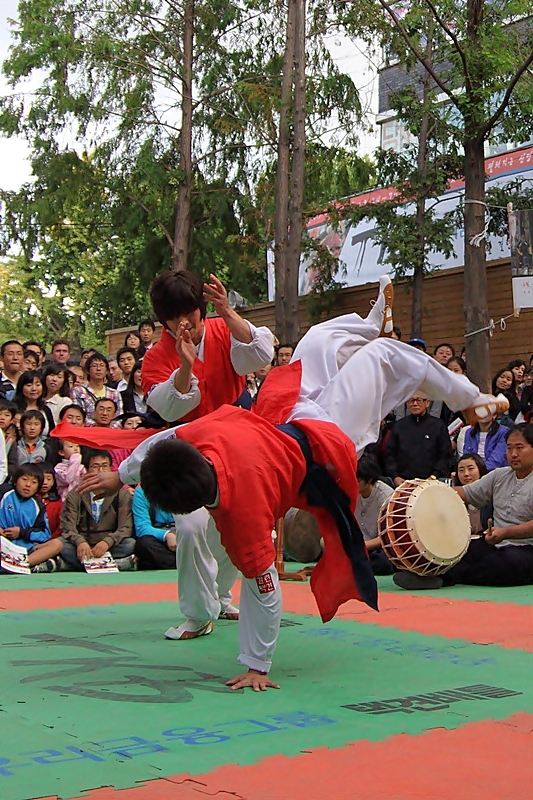
Taekkyeon contains many kinds of techniques, including hand and leg techniques as well as joint locks, throws and head butts. The whole body is used in each movement. Taekkyeon teaches a great variety of kicks, especially low kicks, knees, jumps. The basic steps are geometric and at the core of all advanced movement. All movements are natural to the human body.
The movements of Taekkyon are fluid with the practitioners constantly moving. One of its most striking characteristics is the motion called gumsil or ogeum jil: It is a constant bending and stretching of one's knees, giving the art a dance-like appearance. This motion is also used in the Korea mask dance talchum, so both arts look similar in a way. Taekkeyon does not make use of abrupt knee motions. The principles and methods used to extend the kick put more emphasis on grace and alignment for whole-body strength, as with the arm motions.
In competition, the players must use a foot work called pumbalkki (품밟기) which looks like a dance. The meaning of pumbalkki is "to step the pum". Pum refers to the triangular look of the hanja 品, as pumbalkki has a triangular form as well. The hanja pum means "level" or "goods", but it is used only because of its shape, not because of its meaning.
There are no set forms nor a fixed curriculum within the traditional system. Masters may create their own personalized system for teaching the basic techniques.
Taekkyeon uses a lot of high, medium and low kicks. Sweeps with straight forward low kicks using the ball of the foot and the heel and flowing crescent-like high kicks. There are many kicks that move the leg outward from the middle, which is called gyeot chagi, and inward from the outside using the side of the heels and the side of the feet. The art also uses tricks like inward trips, wall-jumping, fake-outs, tempo, and slide-stepping. The art is also like a dance in which the fighter constantly changes stance from left to right by stepping forward and backwards with arms up and ready to guard, blending arm movements with leg.
As a Sport
When Taekkyeon is practiced in competition, it uses a limited subset of techniques, focusing on grappling and kicking only. Points are scored by throwing (or tripping) the opponent to the ground, pushing him out of the ring, or kicking him in the head. There are no hand strikes or headbutts, and purposefully injuring your opponent is prohibited. The head kicks are often quite sharp, but usually not full force, and fighters may not attempt to wear the opponent down with body blows as in western boxing or muay thai. Matches are sometimes decided by the best of three falls—the first fighter to score two points wins. However, different modern associations employ slightly different rules. To an untrained eye, the matches are cautious but exhilarating affairs. The contestants circle each other warily, changing their footwork constantly using pumbalkki and feinting with low kicks, before exploding into a flurry of action which might leave one fighter flat on his/her back.
Modern Development
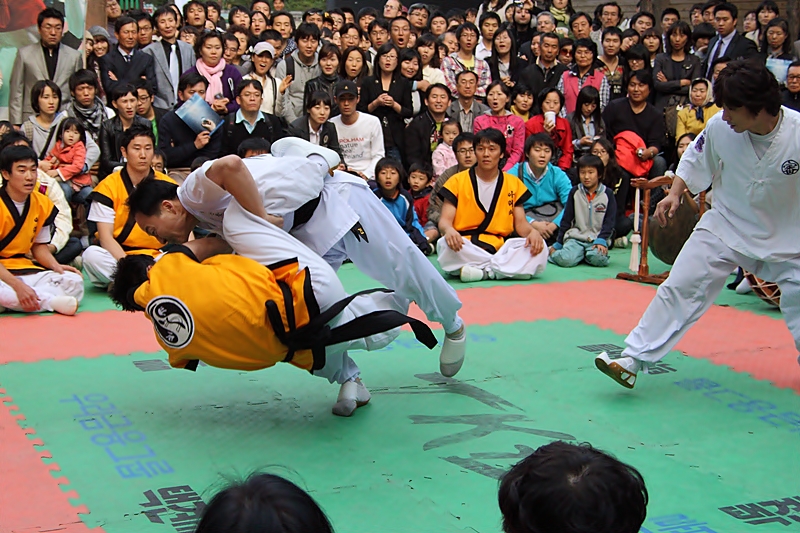
Grandmaster Song Duk-ki and Shin Han-seung were given national treasure status by the South Korean government in 1983. On 3 July 1987, Shin Han-Seung died. Song Duk-ki died on 23 July 1987, at the age of 94. Since this time, several Taekkyeon associations which follow different goals are active.
The only authorized Taekkyeon associations are:
- The Korea Taekkyon Federation (KTF). The KTF is led by Lee Yongbok, who learned from both Song Deok-gi and Shin Han-seung.
- The Korea Traditional Taekgyeon Association (KTTA). The KTTA is led by Jeong Gyeong-hwa who was given the title of "living cultural asset" by the Korean Government. He learned from both Song Deok-gi and Shin Han-seung.
- The Kyulyun Taekyun Association (KTK). The KTK is led by Do Ki-hyun who learned from both Song Deok-gi and Shin Han-seung.
- The World Wide Taekkyeon Organization (WWTO). The WWTO is led by Kwanjang-Nim Go who learnt from Song Duk Ki. The WWTO is based in Los Angeles.
When you reach senior belt you are expected to guide the junior belts when they are beginning Taekwondo such as showing by example. To advance from one rank to the next, students typically complete promotion tests in which they demonstrate their proficiency in the various aspects of the art before a panel of judges or their teacher. View Taekwondo belt levels »
RESOURCES
This article uses material from the Wikipedia article "Taekkyeon", which is released under the Creative Commons Attribution-Share-Alike License 3.0.










